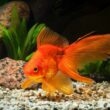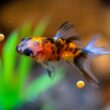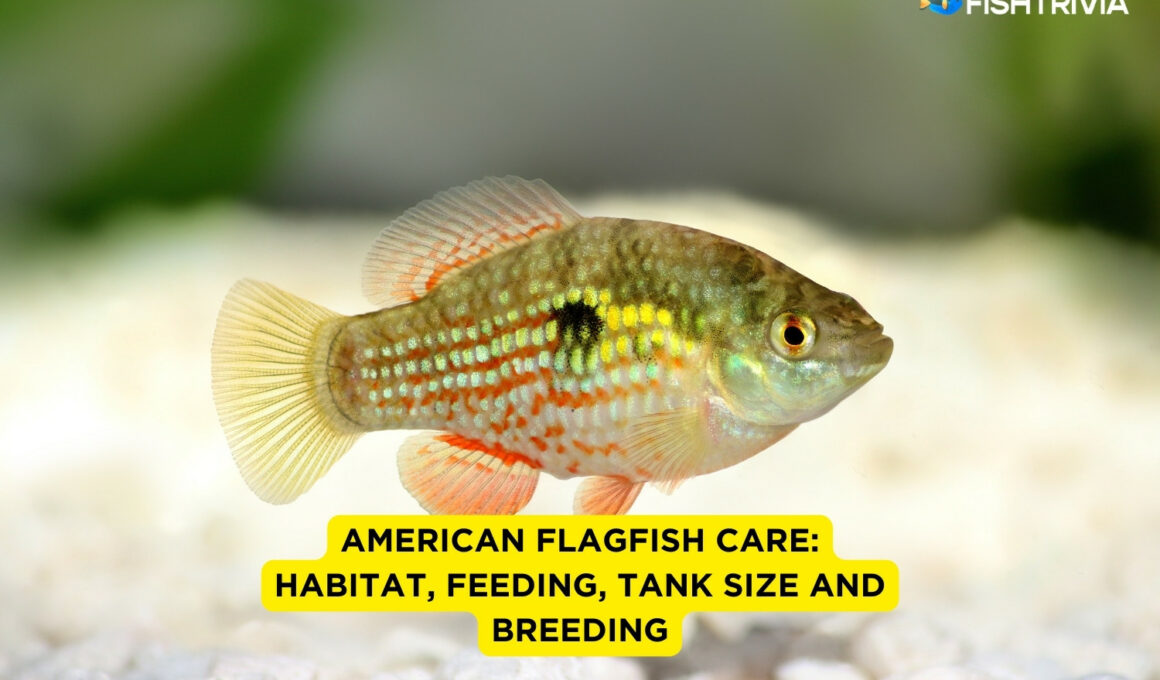In this article Show
The American flag fish species is exceptionally known for being a large and powerful algae consumer. This fish can be viewed as an algae-clearing lawnmower in the water, and it will be pretty happy to help with that.
Although mainly an algae eater, it has a spectacular coloration that includes red and green stripes alternating with light green. When it glimmers, it reflects starlight, which corresponds to the American flag.
The American flagfish species are indigenous to Florida. It generally does not grow larger than 2 inches in the home tank.
The species are predominantly found in lakes, swamps, canals, marshes, and other slow-moving or motionless water bodies. It is adaptable to a broad range of water parameters and can be mated with other fish species.
Also worth reading;
- The Best Betta Fish Tanks 2023: Review & Buying Guide
- Silver Arowana Care Guide: Habitat, Feeding, Tank Size, Breeding
- Bristlenose Pleco Fish Size: How Big Do Bristlenose Grow?
- How To Introduce New Fish To My Aquarium
Tank Size And Other Requirements
A little planning can go a long way with this type of fish. Even if it’s only a few plants and a little cover, you should at least have them.
Driftwoods and some rocks could form some hiding places for this species. It is vital to maintain approximately 64-85 degrees Fahrenheit temperatures and a 6.5 to 8.5 pH in the aquarium.
The Flagfish is smaller compared to other types of fish. In the home aquarium, this species is expected to grow up to 2 inches in length. Due to their reduced sizes, they feel safest in large groups in which they have various possibilities for safety.
An overcrowded aquarium does not work either since the species need a lot of free-swimming room to live effectively. The American Flagfish is remarkably resilient and can thrive in many different environments as long as the correct water conditions are provided.
If you decide to keep a territorial male in your aquarium, you must plan to keep a tank at approximately 10-15 gallons large. This will allow it to calm down, allowing the other fish to flee.
However, you should not be discouraged from owning one of these stunning cold-water fish, as they are fascinating creatures. The fish is quite hardy and relatively quiet. Using dark gravel and brighter illumination helps bring out the beautiful patterns in the aquarium.
While this may sound surprising, one could be shocked to hear that the American flagfish are effective aquarium cleaners, as they adore consuming the hair algae.
When considering the filter for an American flagfish aquarium, be mindful of the current flow. Keeping the current at a low level is made considerably easier by using an air sponge filter.
While also reducing mortality, the life-cycle-centered filter contributes to the safety of the fry, who are at a far higher risk of dying from other filter types.
Can The American Flagfish Do Well In Cold Water Tanks?
The answer to this question will be yes. The American Flagfish make excellent cold-water fish, wherein their vibrant colors may be appreciated up close.
They’re likewise best suited for small ornamented ponds; however, you won’t get as much of a view of their colors as it would happen while in a tank.
American Flagfish adores algae and is remarkably good at feeding on hair algae. Numerous people have adopted these fish to help keep algae in their aquariums under control.
These fishes nibble and consume other vegetation in the aquarium. Thus, it is essential to provide enough foliage to consume and enrich their food with algae tablets. This will reduce the number of vegetation they consume in the aquarium.
American Flagfish is ideal for communal tanks, planted aquariums, and aquariums with chilly water. Ensure that you have an abundance of vegetation and sheltered places. Additionally, they require gentle water flow throughout the tank, but not as much as they are native to smooth streams.
The male flagfish can be aggressive, and you’ll need to keep them in a spacious tank with plenty of open room for swimming. They might become hostile if the aquarium is overpopulated, and therefore, maintaining some covering and planted spaces is critical.
American Flagfish is an excellent choice for cold-water fish tanks and is the best for keeping your aquarium colorful. Thus, ensure you acquire this species for your cold water home aquarium.
Feeding Flagfish In The Aquarium
The American Flagfish is usually an omnivore species. Using a wide range of high-quality foods helps maximize results.
With the assistance of this product, their wonderful natural coloring will emerge. To ensure the diet is nutritionally complete, you should always include a wide range of everyday meals.
It is essential to understand that the American Flagfish consumes nearly everything it finds in the aquarium, right from Algae to plants. Additionally, the most common everyday foods are powdered algae or tablets, green flakes, fruits, and vegetables.
Feeding them with Hikari Tropical Algae Wafers would be a great idea. There are other numerous suitable food products that you may purchase on the Internet or from your local aquarium shop.
Similarly, organic and live food will be taken gratefully. Such foods could include shrimp, mosquito larvae, worms, and daphnia. It is essential to use the preferred foods at least once or twice each week, as regular use could become habitual. They are all nutrient-rich foods, but too many of the foods are not necessarily safe.
Ensure you include vegetables like Cucumber, peas, and zucchini in the diet too. Plants like lettuce and spinach provide some excellent nutritional values, hence, a better choice.
Sexing And Breeding The American FlagFish
You may be surprised to discover that Flagfish is not only simple to breed but relatively easy to maintain. Usually, one does not have to get involved in the process at all.
There will be random breeding for this species when placed in larger tanks, especially during the winter or spring seasons.
The aquarist must first ensure that there are indeed female species in the aquarium. If the female species are not introduced into the fish tank, then there would be no necessity of looking for pregnancies. Genders are highly distinguishable in the American Flagfish species.
Compared to the other breeds, the females tend to be bigger than the males and have a rounder tummy, and have a mark on the back. These features are absent in the male species. The extensive range of colors found in males outweighs the more yellow-colored females.
Since American Flagfish always lay their eggs all about the aquarium, the eggs will be found all over. The infants in the tank are highly vulnerable, so it is essential to have an extra breeding tank. Ensure that the extra breeding tank has higher temperatures than the community tank, regardless of its size. It is also essential to keep the breeding tank stocked with various plants.
The plants form hiding places for the female rather than food this time. During spawning, the male Flagfish can become aggressive and demanding, and therefore a spot should be established for the female to hide and rest safely.
Additionally, it is known that these fish lay their eggs in floating aquatic plant stems and roots. If an egg has been disposed of, it is vital to remove the adults and consume their eggs or young ones.
Holes in the floor or gravel are among the most typical disposition spots. Substrate holes are another popular piece of fish habitat. To guarantee the security of the eggs, the male will safeguard them until they hatch. One should not return the female to the communal tank after she has produced its eggs.
Once the eggs hatch, it is recommended to wait until the newborns can swim freely to distinguish the male ones. In this instance, it takes around seven to ten days. Other significant aspects of the fry’s survival include the aquarium height and filtration.
The American Flagfish are not adapted to strong currents and water that is constantly moving. Naturally, they thrive in ponds and lakes. Ensure you maintain the current at the minimum level. Newborns require a considerable amount of care, and you could potentially hurt them if you don’t utilize a mild filtration procedure.
Another requirement is to ensure that the breeding tank is shallow, as deep tanks will discourage the infants from reaching the surface. If they fail to reach the surface of the tank, they might certainly die.
How To Take Care Of The American Flagfish Newborns
The fry is incredibly vulnerable, and as with all other fish species, they need care. Thus, breeder tanks should be shallow such that the newborns can quickly rise to the surface with ease.
This increases their chances of survival in the breeder tank. During the incubation period, micro worms and infusoria can be supplied to the fry for them to feed on.
While they appear delicate and shrinking when first observed, this species increases every day. When they first start to learn to swim, they are most likely to remain on the floor of the tank since they’re not yet accustomed to swimming. You can immediately shift to a more substantial meal like baby brine shrimp as they become interactive.
Appropriate American FlagFish Tankmates
The American Flagfish gets excited and can become aggressive when it encounters relatively slow fish. An example of a bad option is the Betta fish.
The American FlagFish might even bite this species if placed together. Some of the excellent tank mates for the American Flagfish species include;
- Danios
- Tetras, and
- The Swordtails
These fish have no trouble living alongside each other, regardless of the school size. However, if you’re dedicated to a kind of fish that swims slowly, you should obtain a larger tank to accommodate the many hiding places.
About Hair Algae
The unique characteristic of this species is that it will feed on hair algae. While not necessarily the best choice for every fish tank with hair algae issues, this can be a viable approach for controlling the algae in some tanks.
However, this species is known to consume vegetation and hence could potentially ruin properly aquascaped aquariums.
Conclusion
Not many fishkeepers know about the American flagfish species. Some only keep this species because of its odd attitude and insatiable desire for greens. In contrast, others are interested in getting a stunning burst of color in an algae-ridden aquarium.
The Flagfish is an excellent choice for small ponds and aquariums that have chilly water. Additionally, it is not recommendable for large aquariums.
Instead, tiny and quiet fish tanks are preferable with lots of planting. If you would like to keep these species in your home Aquarium, ensure you get the appropriate requirements and the best tankmates.






